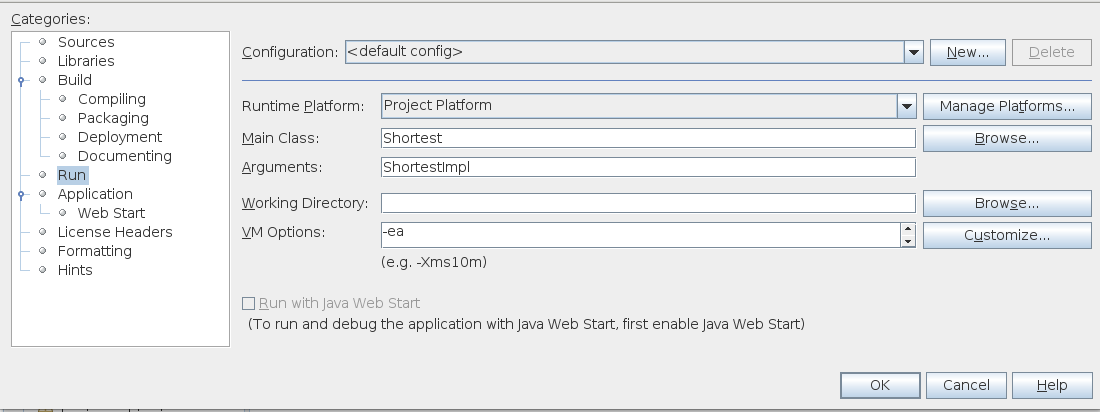Question
MazeSolver.java The Tombs of Mars ( Java ...and the pictures are from Netbeans) The rulers of Mars wish to construct tombs for their eternal rest.
MazeSolver.java
The Tombs of Mars
(Java...and the pictures are from Netbeans)
The rulers of Mars wish to construct tombs for their eternal rest. The objective, for you, is to ensure that a path exists from the tomb's entrance, through the maze of walls, to the placement of the sarcophagus. This lab is based on Dijkstra's Shortest Path Algorithm. (https://en.wikipedia.org/wiki/Dijkstra%27s_algorithm)
In this lab you will extends the abstract class named "Shortest" instead of implementing an interface. You should configure Netbeans the same way you did before, except you treat your extension of Shortest as the implementation of the interface Shortest is testing, i.e. you set the project properties > Run > Arguments to the class name you create. As usual, you need to also set "-ea" in VM Options.

[And for the argument, it is supposed to actullay be "MazeSolver.ShortestImpl" (If MazeSolver is the package name)]
Steps
1. Create the constructor. The constructor for your class must take two integers and call the corresponding constructor on the superclass.
2. Implement the nearest method(). Read the comments on the method in Shortest for instructions.
3. Implement the markPaths() method. Read the comments on the method in Shortest for instructions.
4. Implement the findPath() method. Read the comments on the method in Shortest for instructions.
The algoithm of finding the shortest path is implemented by the combination of markPaths() and findPath().
Thought Question: If you use java.util.LinkedList for your queue, What happens if you use it like a stack instead (i.e. you replace add() and remove() with push() and pop())?
Shortest.java import java.util.*; import java.io.*; /** * Find the shortest path through the Martian tomb. */ public abstract class Shortest { public final static int WALL = Integer.MAX_VALUE; public final static int EMPTY = Integer.MAX_VALUE - 1; LinkedList */ public abstract List |
Coord.java /** * A class describing a coordinate x,y * on a grid. */ class Coord implements Comparable { final int x,y; public Coord(int x,int y) { this.x = x; this.y = y; } public String toString() { return String.format("(%d,%d)",x,y); } /** * Allow it to be compared. */ public boolean equals(Object o) { Coord c = (Coord)o; return x == c.x && y == c.y; } /** * Allow it to be sorted. */ public int compareTo(Object other) { Coord that = (Coord)other; int diff = this.x - that.x; if(diff == 0) diff = this.y - that.y; return diff; } } |
Check.java import java.util.*; public class Check { Map m = new HashMap(); public Check() { m.put(0,44); m.put(1,44); m.put(2,44); m.put(3,44); m.put(4,44); m.put(5,44); m.put(6,44); m.put(7,44); m.put(8,44); m.put(9,44); m.put(10,44); m.put(11,44); m.put(12,44); m.put(13,44); m.put(14,44); m.put(15,44); m.put(16,44); m.put(17,44); m.put(18,44); m.put(19,44); m.put(20,44); m.put(21,44); m.put(22,44); m.put(23,44); m.put(24,44); m.put(25,44); m.put(26,44); m.put(27,44); m.put(28,44); m.put(29,44); m.put(30,44); m.put(31,44); m.put(32,44); m.put(33,44); m.put(34,44); m.put(35,44); m.put(36,44); m.put(37,44); m.put(38,44); m.put(39,44); m.put(40,44); m.put(41,44); m.put(42,44); m.put(43,44); m.put(44,44); m.put(45,44); m.put(46,44); m.put(47,44); m.put(48,44); m.put(49,44); m.put(50,44); m.put(51,44); m.put(52,44); m.put(53,44); m.put(54,44); m.put(55,44); m.put(56,44); m.put(57,44); m.put(58,44); m.put(59,44); m.put(60,44); m.put(61,44); m.put(62,44); m.put(63,44); m.put(64,44); m.put(65,44); m.put(66,44); m.put(67,44); m.put(68,44); m.put(69,44); m.put(70,44); m.put(71,44); m.put(72,44); m.put(73,44); m.put(74,46); m.put(75,46); m.put(76,46); m.put(77,46); m.put(78,46); m.put(79,46); m.put(80,46); m.put(81,46); m.put(82,46); m.put(83,46); m.put(84,46); m.put(85,46); m.put(86,46); m.put(87,46); m.put(88,46); m.put(89,46); m.put(90,46); m.put(91,46); m.put(92,46); m.put(93,46); m.put(94,46); m.put(95,46); m.put(96,46); m.put(97,46); m.put(98,46); m.put(99,46); m.put(100,46); m.put(101,46); m.put(102,46); m.put(103,46); m.put(104,46); m.put(105,46); m.put(106,46); m.put(107,46); m.put(108,46); m.put(109,46); m.put(110,46); m.put(111,46); m.put(112,46); m.put(113,46); m.put(114,46); m.put(115,46); m.put(116,46); m.put(117,46); m.put(118,46); m.put(119,46); m.put(120,46); m.put(121,46); m.put(122,52); m.put(123,52); m.put(124,52); m.put(125,52); m.put(126,52); m.put(127,52); m.put(128,52); m.put(129,52); m.put(130,52); m.put(131,52); m.put(132,52); m.put(133,52); m.put(134,52); m.put(135,52); m.put(136,52); m.put(137,52); m.put(138,52); m.put(139,56); m.put(140,56); m.put(141,56); m.put(142,56); m.put(143,56); m.put(144,56); m.put(145,56); m.put(146,56); m.put(147,56); m.put(148,56); m.put(149,56); } } |
Step by Step Solution
There are 3 Steps involved in it
Step: 1

Get Instant Access to Expert-Tailored Solutions
See step-by-step solutions with expert insights and AI powered tools for academic success
Step: 2

Step: 3

Ace Your Homework with AI
Get the answers you need in no time with our AI-driven, step-by-step assistance
Get Started


